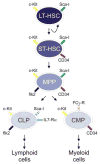DNA repair is crucial for maintaining hematopoietic stem cell function
- PMID: 18248857
- PMCID: PMC2731414
- DOI: 10.1016/j.dnarep.2007.11.012
DNA repair is crucial for maintaining hematopoietic stem cell function
Abstract
Richard Cornall and collaborators recently developed a mouse model of Ligase IV syndrome with growth retardation and immunodeficiency due to a defect in nonhomologous end-joining (NHEJ) of DNA double-strand breaks. They demonstrated age-dependent loss of hematopoietic stem cell function in these mice. Simultaneously, Irving Weissman and colleagues demonstrated a similar phenomenon in Ku80(-/-) mice defective in NHEJ and telomere maintenance, Xpd(TTD) mice defective in nucleotide excision repair, and late generation mTr(-/-) missing telomerase activity. These studies strongly support the hypothesis that genomic stress causes aging by limiting the ability of stem cells to indefinitely maintain tissue homeostasis.
Figures


Similar articles
-
DNA repair is limiting for haematopoietic stem cells during ageing.Nature. 2007 Jun 7;447(7145):686-90. doi: 10.1038/nature05875. Nature. 2007. PMID: 17554302
-
Deficiencies in DNA damage repair limit the function of haematopoietic stem cells with age.Nature. 2007 Jun 7;447(7145):725-9. doi: 10.1038/nature05862. Nature. 2007. PMID: 17554309
-
Radiation-induced genomic rearrangements formed by nonhomologous end-joining of DNA double-strand breaks.Cancer Res. 2001 May 15;61(10):3886-93. Cancer Res. 2001. PMID: 11358801
-
The role of the nonhomologous end-joining DNA double-strand break repair pathway in telomere biology.Annu Rev Genet. 2006;40:237-77. doi: 10.1146/annurev.genet.39.110304.095755. Annu Rev Genet. 2006. PMID: 16822175 Review.
-
DNA repair defects in stem cell function and aging.Annu Rev Med. 2005;56:495-508. doi: 10.1146/annurev.med.56.082103.104546. Annu Rev Med. 2005. PMID: 15660524 Review.
Cited by
-
Cell autonomous and nonautonomous mechanisms drive hematopoietic stem/progenitor cell loss in the absence of DNA repair.Stem Cells. 2013 Mar;31(3):511-25. doi: 10.1002/stem.1261. Stem Cells. 2013. PMID: 23097336 Free PMC article.
-
Accumulation of DNA damage in hematopoietic stem and progenitor cells during human aging.PLoS One. 2011 Mar 7;6(3):e17487. doi: 10.1371/journal.pone.0017487. PLoS One. 2011. PMID: 21408175 Free PMC article.
-
Caspase-9 is required for normal hematopoietic development and protection from alkylator-induced DNA damage in mice.Blood. 2014 Dec 18;124(26):3887-95. doi: 10.1182/blood-2014-06-582551. Epub 2014 Oct 27. Blood. 2014. PMID: 25349173 Free PMC article.
-
Transcription Factors, R-Loops and Deubiquitinating Enzymes: Emerging Targets in Myelodysplastic Syndromes and Acute Myeloid Leukemia.Cancers (Basel). 2021 Jul 26;13(15):3753. doi: 10.3390/cancers13153753. Cancers (Basel). 2021. PMID: 34359655 Free PMC article. Review.
-
Genotoxic consequences of endogenous aldehydes on mouse haematopoietic stem cell function.Nature. 2012 Sep 27;489(7417):571-5. doi: 10.1038/nature11368. Epub 2012 Aug 26. Nature. 2012. PMID: 22922648
References
-
- D’Errico M, Lemma T, Calcagnile A, Proietti De Santis L, Dogliotti E. Cell type and DNA damage specific response of human skin cells to environmental agents. Mutat Res. 2007;614:37–47. - PubMed
-
- Nouspikel T. DNA repair in differentiated cells: some new answers to old questions. Neuroscience. 2007;145:1213–1221. - PubMed
-
- Bracker TU, Giebel B, Spanholtz J, Sorg UR, Klein-Hitpass L, Moritz T, Thomale J. Stringent regulation of DNA repair during human hematopoietic differentiation: a gene expression and functional analysis. Stem Cells. 2006;24:722–730. - PubMed
-
- Chen MF, Lin CT, Chen WC, Yang CT, Chen CC, Liao SK, Liu JM, Lu CH, Lee KD. The sensitivity of human mesenchymal stem cells to ionizing radiation. Int J Radiat Oncol Biol Phys. 2006;66:244–253. - PubMed
-
- Weissman IL. Stem cells: units of development, units of regeneration, and units in evolution. Cell. 2000;100:157–168. - PubMed
Publication types
MeSH terms
Grants and funding
LinkOut - more resources
Full Text Sources
Other Literature Sources
Medical
Research Materials

